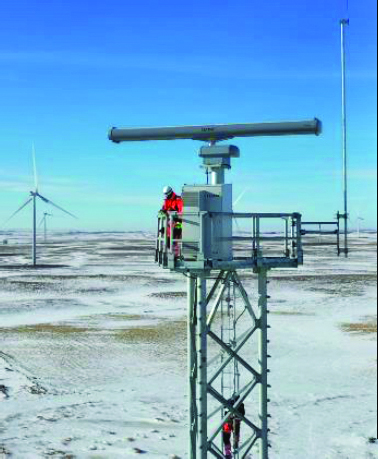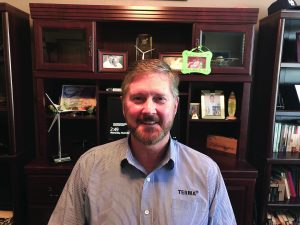What is Terma and what does it do for the wind-energy industry?
Terma is a global defense and security company that has been in business for more than 70 years. We have more than 3,000 radars installed world-wide for various applications from border security and coastal surveillance to use at airports as a surface movement radar and on naval ships. This is not a new radar, but a mature, proven product that we are simply applying to a new business area — the wind-energy industry.
Our range, and ability to reliably detect small targets traveling in and around a wind farm, despite the interference that’s generated by the moving blades of the wind turbine itself, allow us to do two things: provide obstruction lighting control (OLC) to address the aircraft detection lighting system (ADLS) requirements of the Federal Aviation Administration (FAA), and satisfy the wind-turbine radar interference mitigation (WTRIM) requirements of the Department of Defense (DoD), Department of Homeland Security (DHS), FAA, and the Bureau of Ocean Energy Management (BOEM).
We are the only radar manufacturer that provides a solution to both of these problems facing wind-energy development in North America today.
In fact, we are the world’s leading provider of operationally deployed ADLS and WTRIM solutions with more than a dozen ADLS projects in both Europe and North America, as well as eight WTRIM projects operating in Europe at both civilian and military installations.
What type of radar technology is involved in ADLS projects?
For the ADLS application, we use the SCANTER 5202, a commercial off-the-shelf (COTS), X-band, 2D, fully coherent pulse compression radar. Through a combination of advanced technology such as solid-state power amplifiers (SSPA), multiple transmission frequencies (i.e., frequency diversity), pulse-compression, coherent integration and cutting-edge signal processing, the surveillance radar is specifically tailored for detecting and tracking very small cooperative and non-cooperative targets in high-clutter environments and under a variety of extreme weather conditions (i.e., heavy rain, snow, ice, fog).
Our range (i.e., 32-mile diameter circle of coverage) is accomplished using a 200-W transceiver and 18-foot high-gain (HG) antenna, which, combined with our detection performance (i.e., the ability to detect and track targets flying in and around a wind farm despite the noise generated by the turbines themselves) allow us to theoretically site the radar almost anywhere, from the dead center of the wind farm to anywhere around the inner or outer edge of the wind-farm boundary to even on the roof of a multi-story hotel five miles away from the wind farm (assuming, of course, we have the range to cover the back side of the wind farm from that location). This provides the customer great flexibility in siting and deploying the ADLS.

What are the benefits of ADLS?
Simply put, the ADLS is nothing more than a tool that allows the wind farm to be built. In some cases, it satisfies mandatory requirements imposed by the state, county, or other local siting authority. In others, it satisfies the community’s desire for dark skies. The ADLS allows the developer to balance the aircraft safety requirements of the FAA with the community’s desire for better aesthetics associated with the wind farm.
We’ve taken those concerns a step farther by implementing an ADLS that can be configured as one zone or as multiple, asymmetric, autonomous zones with fused-data presentation. For instance, if there is a 10-mile by 10-mile wind farm, there’s no need to turn on the lights in three-quarters of the wind farm if a target is crossing the southeastern edge of the wind farm. If the customer would like to consider separately defined zones, we can implement that rather easily.
What makes up the functionality of ADLS?
The system is functionally comprised of three components: the radar, a light control server (LCS) that monitors the radar messages and, when necessary, enables the lights via the lights’ individual light control modules (LCM), which keep the lights in a hot-standby mode so that, when triggered, all the lights are enabled at once and in sync.
What do you need from a customer in order to begin?
First and foremost, we need the layout of the wind farm with turbine locations and project boundary. From there, we perform an initial coverage analysis to determine how many radars are required and the heights at which the radar is installed. Typically, we only need one radar to do the job, but in some cases where terrain presents difficult line-of-sight challenges, we may need to use multiple radars. It’s not unusual, in that case, to spend weeks working with a customer to nail down the exact radar location(s) to ensure efficient and economic siting of the radar.
Since your primary responsibility is to control the obstruction lights mounted on a wind turbine, are you able to work with the various wind turbine and lighting manufacturers?
Yes, we are turbine and lighting manufacturer agnostic. So far, we’ve executed ADLS projects with Vestas, Siemens, GE, and Nordex turbines. In terms of the obstruction lights, we don’t choose the lights being used at the wind farm; those are typically chosen by the developer or their engineering, procurement, and construction (EPC) contractor in a competitive procurement process. To this point, we’ve focused our testing and integration resources on the obstruction lights being used at our first dozen projects (i.e., Orga and Quantec). By the end of this calendar year (2020), we will be fully integrated and tested with ITL and Flash/SPX as well.
Any last thoughts?
I began my career as an information technology grunt, programming surveillance and weapons systems for the U.S. Navy. My career took a meandering path along the technology trail until I ended up selling radars for Terma. The radar we use for ADLS is the exact same radar we’ve sold all over North America for various business applications. It’s nothing new.
What is new, is applying radar technology to the wind-energy industry. There are many applications for radar in wind, from ADLS and WTRIM, to bird and drone detection and tracking, and even for pre-siting of a wind farm to avoid avian fatalities. I think we’re just scratching the surface of radar’s potential. I’m also excited to be working with the young, very talented professionals that make up the wind-energy industry. It’s exciting, and it seems to be really taking off. And, of course, I appreciate the opportunity to share my story with you.
More info www.terma.com































